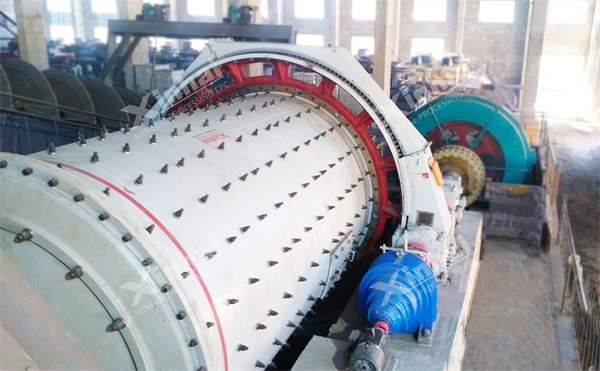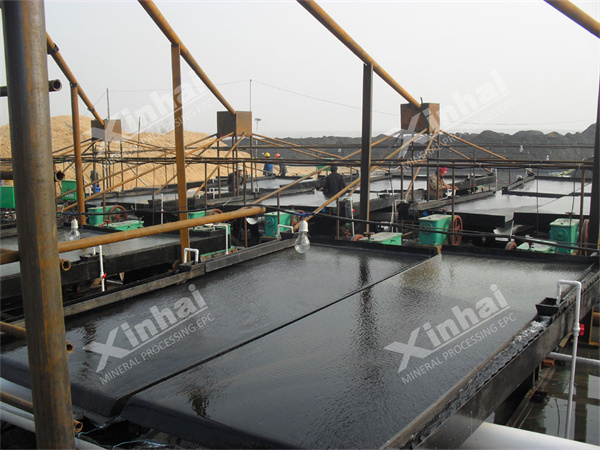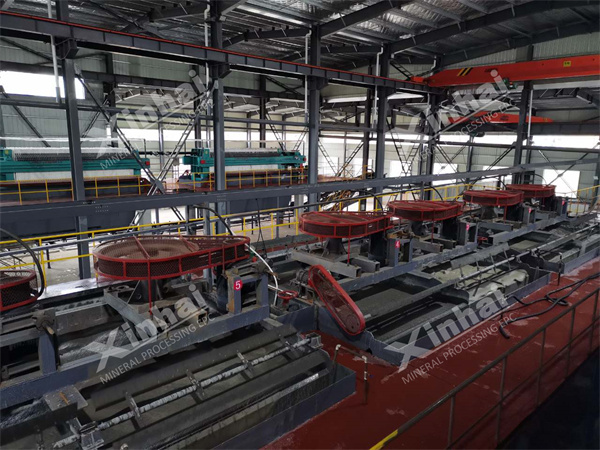Xinhai conducted beneficiation experiments for the Xinyuan Gold Mine beneficiation project in Cambodia. Based on the experimental results, a combined beneficiation flotation process was designed for the project. In addition, a tailings dewatering (dry tailings discharge) process was also designed for the beneficiation plant.
The crushing and screening stage adopts a two-stage closed-loop crushing and screening process.
(1) The raw ore is stored in the raw ore yard and loaded onto the mine using a forklift.
(2) A trough feeder is installed at the bottom of the raw ore bin, which is fed into the 1 # belt conveyor and transported to the jaw crusher for coarse crushing. The coarse crushed products are manually selected on the 2 # belt conveyor, and the waste stones are directly discarded;
(3) After manual selection, the materials are transported by the 3 # belt conveyor to the circular vibrating screen for screening. The screened materials (+13.5mm) are transported by the 4 # belt conveyor to the cone crusher for fine crushing. The fine products and manually selected materials are returned to the vibrating screen together, forming a closed circuit crushing.
(4) The screened material (-13.5mm) is the qualified material in the crushing stage, which is transported by the 5 # belt conveyor to the powder ore bin.

Adopting a process flow of closed circuit grinding+gravity separation+flotation (one roughing, two sweeping, and two refining).
(1) An electric vibrating feeder is installed at the bottom of the powder ore bin, which is fed into the 6 # belt conveyor and transported to the straight cylindrical ball mill for grinding. The discharge end is equipped with a cylindrical screen, and the large particles on the screen are transported back to the ball mill by the 7 # belt conveyor;
(2) The screened slurry is pumped into a water jacket centrifugal concentrator for re selection, and the concentrate flows into a 6-S shaking table for selection. The selected concentrate is the re selected gold concentrate, and the selected tailings are returned to the ball mill;
(3) The tailings of the centrifugal machine are pumped into a hydrocyclone for classification, and the bottom flow returns to the ball mill for further grinding, forming a closed circuit grinding process with a grinding fineness of -200 mesh, accounting for 80%.

(4) The overflow of the cyclone flows automatically to the high-efficiency mixing tank for dosing and slurry mixing, and then flows automatically to the SF-2.8 flotation machine for rough separation. The rough foam products flow automatically to the SF-2.8 flotation machine for two-stage cleaning (2/2). After two-stage cleaning, the flotation gold concentrate is obtained. The products in the refined I and refined II tanks return to the previous operation in turn;
(5) The products in the roughing cell flow to the two scavenging operations. The flotation machines for the two scavenging operations are SF-2.8 flotation machines. The foam products of scavenging I and scavenging II also return to the previous operation in turn. The tailings of scavenging II are the final flotation tailings.
The flotation gold concentrate is dehydrated using a thickener+filter press.
The concentration of gold concentrate adopts one high-efficiency transformation thickener, and the pressure filter adopts a pressure filter. The filter cake is the final concentrate, which is transported by the 8 # belt conveyor to the concentrate storage facility for storage. The filtrate and thickener overflow can both flow into the return water tank and return to the system for reuse.

The flotation tailings are discharged dry using a dewatering cyclone, dewatering screen, thickener, and filter press.
Use a pump to pump the tailings slurry into a dewatering cyclone, where the bottom flow of the cyclone flows automatically to the dewatering screen; The overflow enters the high-efficiency multi cone thickener for concentration, and the bottom flow of the thickener is pumped into the filter press with a slurry pump for filtration. The materials on the filter cake and dewatering screen are all dry tailings, which are transported by the 9 # belt conveyor to the tailings storage site for storage. The screened water is pumped back to the thickener; The filtrate and thickener overflow can both flow into the return water tank and be returned to production for use.